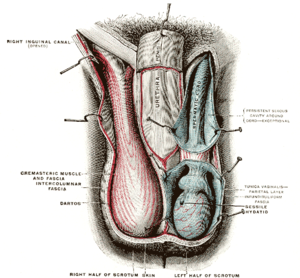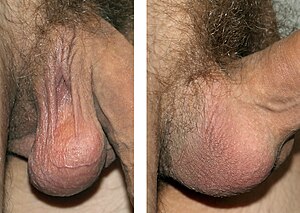Difference between revisions of "Scrotum"
m (added section Function from WP) |
m (using REFbook key ISBN) |
||
| Line 23: | Line 23: | ||
|location=Dubuque, {{USSC|IA}} | |location=Dubuque, {{USSC|IA}} | ||
|publisher=William C. Brown Publishers | |publisher=William C. Brown Publishers | ||
| − | | | + | |ISBN=978-0697056757 |
|date=1989 | |date=1989 | ||
|pages=935-6 | |pages=935-6 | ||
| Line 45: | Line 45: | ||
|title=Reproductive Physiology of Marsupials | |title=Reproductive Physiology of Marsupials | ||
|publisher=Cambridge University Press | |publisher=Cambridge University Press | ||
| − | | | + | |ISBN=978-0-521-33792-2 |
}}</ref><ref>{{REFbook | }}</ref><ref>{{REFbook | ||
|last=Hyman | |last=Hyman | ||
| Line 55: | Line 55: | ||
|publisher=University of Chicago Press | |publisher=University of Chicago Press | ||
|pages=583– | |pages=583– | ||
| − | | | + | |ISBN=978-0-226-87013-7 |
}}</ref><ref>{{REFbook | }}</ref><ref>{{REFbook | ||
|last=Jones | |last=Jones | ||
| Line 69: | Line 69: | ||
|title=Predators with Pouches: The Biology of Carnivorous Marsupials | |title=Predators with Pouches: The Biology of Carnivorous Marsupials | ||
|publisher=Csiro Publishing | |publisher=Csiro Publishing | ||
| − | | | + | |ISBN=978-0-643-06634-2 |
}}</ref><ref>{{REFbook | }}</ref><ref>{{REFbook | ||
|last=Saunders | |last=Saunders | ||
| Line 80: | Line 80: | ||
|title=Marsupial Biology: Recent Research, New Perspectives | |title=Marsupial Biology: Recent Research, New Perspectives | ||
|publisher=UNSW Press | |publisher=UNSW Press | ||
| − | | | + | |ISBN=978-0-86840-311-3 |
}}</ref> which is not homologous to the scrotum of placental mammals,<ref>{{REFbook | }}</ref> which is not homologous to the scrotum of placental mammals,<ref>{{REFbook | ||
|last=Armati | |last=Armati | ||
| Line 95: | Line 95: | ||
|title=Marsupials | |title=Marsupials | ||
|publisher=Cambridge University Press | |publisher=Cambridge University Press | ||
| − | | | + | |ISBN=978-1-139-45742-2 |
}}</ref> | }}</ref> | ||
although there are several marsupial species without an external scrotum.<ref>{{REFbook | although there are several marsupial species without an external scrotum.<ref>{{REFbook | ||
| Line 104: | Line 104: | ||
|title=Life of Marsupials | |title=Life of Marsupials | ||
|publisher=Csiro Publishing | |publisher=Csiro Publishing | ||
| − | | | + | |ISBN=978-0-643-06257-3 |
}}</ref> In humans, the scrotum may provide some friction during intercourse, helping to enhance the activity.<ref>{{REFbook | }}</ref> In humans, the scrotum may provide some friction during intercourse, helping to enhance the activity.<ref>{{REFbook | ||
|last=Jones | |last=Jones | ||
| Line 113: | Line 113: | ||
|publisher=Academic Press | |publisher=Academic Press | ||
|page=74 | |page=74 | ||
| − | | | + | |ISBN=9780123821850 |
|quote=The rear-entry position of mating may allow the scrotum to stimulate the clitoris and, in this way, may produce an orgasm ... | |quote=The rear-entry position of mating may allow the scrotum to stimulate the clitoris and, in this way, may produce an orgasm ... | ||
}}</ref> | }}</ref> | ||
Revision as of 11:31, 22 December 2021
The scrotum is found in most male mammals, including humans. It is the sack that contains the testes. In humans the scrotum hangs just below the penis. It is described as follows:
the pouch that contains the testes and their accessory organs. It is composed of skin, the tunica dartos, fascia, and the tunica vaginalis testis. Each testis is connected to a cremaster muscle descending from the abdominal wall. During cold weather these muscles draw the testes closer to the body to maintain their temperature, and in hot weather the reverse occurs; the scrotum usually follows this movement.[1]
Function
(The following text or part of it is quoted from the free Wikipedia:)
The scrotum regulates the temperature of the testes and maintains it at 35 degrees Celsius (95 degrees Fahrenheit), i.e. two or three degrees below the body temperature of 37 degrees Celsius (99 degrees Fahrenheit). Higher temperatures affect spermatogenesis[2]. Temperature control is accomplished by the smooth muscles of the scrotum moving the testicles either closer to or further away from the abdomen dependent upon the ambient temperature. This is accomplished by the cremaster muscle in the abdomen and the dartos fascia (muscular tissue under the skin).[2]
Having the scrotum and testicles situated outside the abdominal cavity may provide additional advantages. The external scrotum is not affected by abdominal pressure. This may prevent the emptying of the testes before the sperm were matured sufficiently for fertilization[2]. Another advantage is it protects the testes from jolts and compressions associated with an active lifestyle. Animals that move at a steady pace – such as elephants, whales, and marsupial moles – have internal testes and no scrotum.[3] Unlike placental mammals, some male marsupials have a scrotum that is anterior to the penis,[4][5][6][7] which is not homologous to the scrotum of placental mammals,[8] although there are several marsupial species without an external scrotum.[9] In humans, the scrotum may provide some friction during intercourse, helping to enhance the activity.[10]
References
- ↑
 (2003).
(2003). Scrotum
, The Free Dictionary. Retrieved 21 December 2021. - ↑ a b c
 Van de Graaff KM, Fox SI: Concepts of Human Anatomy and Physiology. Dubuque, IA: William C. Brown Publishers. Pp. 935-6. ISBN 978-0697056757.
Van de Graaff KM, Fox SI: Concepts of Human Anatomy and Physiology. Dubuque, IA: William C. Brown Publishers. Pp. 935-6. ISBN 978-0697056757.
- ↑
 (17 August 1996).
(17 August 1996). Science : Bumpy lifestyle led to external testes
, New Scientist. Retrieved 6 November 2007. - ↑
 Tyndale-Biscoe H, Renfree M (1987): Reproductive Physiology of Marsupials. Cambridge University Press. ISBN 978-0-521-33792-2.
Tyndale-Biscoe H, Renfree M (1987): Reproductive Physiology of Marsupials. Cambridge University Press. ISBN 978-0-521-33792-2.
- ↑
 Hyman LH (1992): Hyman's Comparative Vertebrate Anatomy. University of Chicago Press. Pp. 583–. ISBN 978-0-226-87013-7.
Hyman LH (1992): Hyman's Comparative Vertebrate Anatomy. University of Chicago Press. Pp. 583–. ISBN 978-0-226-87013-7.
- ↑
 Jones M, Dickman CR, Archer M (2003): Predators with Pouches: The Biology of Carnivorous Marsupials. Csiro Publishing. ISBN 978-0-643-06634-2.
Jones M, Dickman CR, Archer M (2003): Predators with Pouches: The Biology of Carnivorous Marsupials. Csiro Publishing. ISBN 978-0-643-06634-2.
- ↑
 Saunders N, Hinds L (1997): Marsupial Biology: Recent Research, New Perspectives. UNSW Press. ISBN 978-0-86840-311-3.
Saunders N, Hinds L (1997): Marsupial Biology: Recent Research, New Perspectives. UNSW Press. ISBN 978-0-86840-311-3.
- ↑
 Armati PJ, Dickman CR, Hume ID (2006): Marsupials. Cambridge University Press. ISBN 978-1-139-45742-2.
Armati PJ, Dickman CR, Hume ID (2006): Marsupials. Cambridge University Press. ISBN 978-1-139-45742-2.
- ↑
 Tyndale-Biscoe CH (2005): Life of Marsupials. Csiro Publishing. ISBN 978-0-643-06257-3.
Tyndale-Biscoe CH (2005): Life of Marsupials. Csiro Publishing. ISBN 978-0-643-06257-3.
- ↑
 Jones R (2013): Human Reproductive Biology. Academic Press. P. 74. ISBN 9780123821850.
Jones R (2013): Human Reproductive Biology. Academic Press. P. 74. ISBN 9780123821850.
Quote:The rear-entry position of mating may allow the scrotum to stimulate the clitoris and, in this way, may produce an orgasm ...

